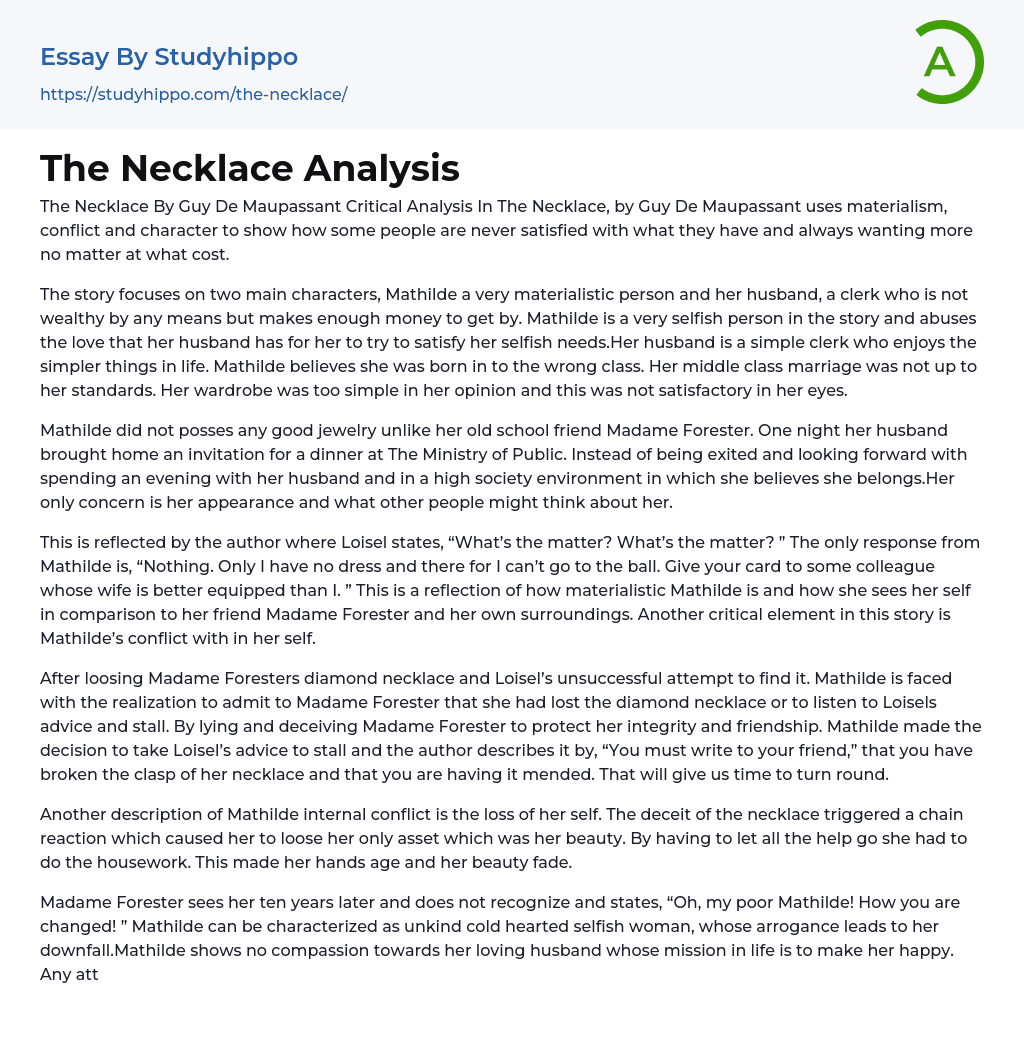Guy De Maupassant's "The Necklace" employs materialism, conflict, and character to demonstrate how certain individuals are perpetually dissatisfied with their circumstances, greedily seeking more at any expense.
In this story, we encounter two main characters: Mathilde, portrayed as a very materialistic individual, and her husband, a clerk who lives modestly. While Mathilde is quite self-centered in the story, her husband takes pleasure in the simpler things in life. Mathilde feels discontent with her social class and holds her middle-class marriage to a high standard. She demands more than what her husband can provide, despite his earnest love for her. According to Mathilde, her wardrobe is too simple and does not meet her standards.
Mathilde lacked quality jewelry, unlike her former classmate Madame Forester, who possessed it. When her husband presented her with an invitation
...to dine at The Ministry of Public, rather than feeling excited and anticipating spending an evening with him in a high-society atmosphere, which she believed she deserved, her only worry was her appearance and what others might think of her.
This passage illustrates Mathilde's materialistic nature and her struggle against her internal conflicts. In indicating this, Loisel quotes Mathilde's statement, "What's the matter? What's the matter?" which is met with the simple response, "Nothing. Only I have no dress and therefore I can't go to the ball. Give your card to some colleague whose wife is better equipped than I." This serves to highlight Mathilde's perception of herself in relation to her surroundings and her friend Madame Forester.
Following the loss of Madame Forester's diamond necklace and Loisel's fruitless efforts to recover it, Mathilde is left with a choice: confess to Madam
Forester or follow Loisel's suggestion to delay. Mathilde ultimately decides to protect her integrity and friendship by resorting to lies and deceit, opting to follow Loisel's advice and stall. In the author's words, "You must write to your friend" and explain that the necklace's clasp has broken and is being mended, which will buy them some time to figure things out.
Mathilde's inner turmoil was further exacerbated by her loss of self. The necklace deception set off a series of events that caused her to lose the only thing she possessed, her beauty. As a result of having to dismiss all her staff, she had to take care of the household chores herself, causing her hands to age and her beauty to fade.
Madame Forester encounters Mathilde again after a decade and fails to recognize her as she exclaims, "Oh, my poor Mathilde! How you are changed!" Mathilde's character is best described as unkind, cold-hearted, and selfish, who ultimately faces the consequences of her prideful behavior. Her lack of empathy towards her devoted husband, who endlessly strives to make her happy, exemplifies her arrogant disposition. Loisel gives his wife money to purchase a dress for the upcoming ball. However, instead of being grateful, Mathilde becomes upset once again as she laments the absence of jewelry and stones to wear with the dress.
The way I present myself might suggest that I am troubled. It could be said that this is typical behavior for someone who is unhappy and lacks confidence. This individual doesn't have enough faith in themselves to realize that clothing and jewelry don't define a person's worth.
Guy De Maupassant's "The Necklace" is a captivating
story that ultimately leads to an ironic twist. Mathilde's self-centered nature and the loss of the necklace result in her experiencing what she feared most in life. In order to repay the borrowed necklace, she must resort to doing housework and wearing less expensive clothing. Mathilde's selfishness not only affects herself, but also drags down Loisel, who always loved and supported her unconditionally. All of this happens because she believes that the dress her husband bought her is not good enough. After a decade, Mathilde discovers that the borrowed necklace was not even made of real diamonds.
By reading "The Necklace" by Guy De Maupassant, readers may reflect on their own lives and reconsider the importance of material possessions. The story also emphasizes the importance of being truthful and facing consequences rather than resorting to lies, which may have severe repercussions.
The information provided is from Ann Charter's book titled "The Story and Its Writer" which was published by Stratford Publishing Services in 2007. The specific pages being referred to are 838-844.
- 1984 essays
- A Farewell to Arms essays
- A Good Man Is Hard to Find essays
- A Hanging essays
- A Lesson Before Dying essays
- A Long Way Gone essays
- A Rose For Emily essays
- A Separate Peace essays
- A Tale Of Two Cities essays
- A Very Old Man With Enormous Wings essays
- Adventures Of Huckleberry Finn essays
- Alice in Wonderland essays
- All Quiet on The Western Front essays
- Allegory of the Cave essays
- An occurrence at owl creek bridge essays
- Animal Farm essays
- Anthem essays
- Antigone essays
- Arthur Conan Doyle essays
- As I Lay Dying essays
- Atticus Finch essays
- Barn Burning essays
- Battle Royal essays
- Beauty and The Beast essays
- Beloved essays
- Boo Radley essays
- Brave New World essays
- Candide essays
- Castle essays
- Characters In Hamlet essays
- Characters In Romeo And Juliet essays
- Christmas carol essays
- Chronicle of a Death Foretold essays
- Cinderella essays
- Crime and Punishment essays
- Daisy Miller essays
- Death of a Salesman American Dream essays
- Desdemona essays
- Diary Of A Wimpy Kid essays
- Dracula essays
- Dubliners essays
- Emma essays
- Ender'S Game essays
- Ethan Frome essays
- Eveline essays
- Fahrenheit 451 essays
- First-Person Narrative essays
- Fish Cheeks essays
- Frankenstein essays
- Genesis essays




